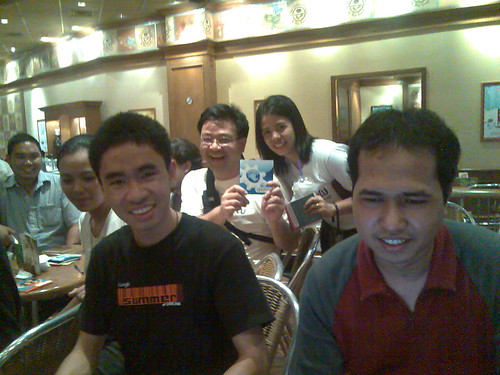I can hear the question now: What kind of guy puts The Iliad and War and Peace on a list of things to read for fun? Well, me. I think that reading things by authors I ve never read before, people that take positions I haven t heard of before or don t agree with, or works that are challenging, will teach me something. And learning is fun.
My
entire list for 2010 is at Goodreads. I ve highlighted a few below. I don t expect to read all 34 books on the Goodreads list necessarily, but there is the chance.
The Iliad by Homer, 750BC, trans. by Alexander Pope, 704 pages. A recent
NPR story kindled my interest in this work. I m looking forward to it.
The Oxford History of the Classical World by Boardman, Griffin, and Murray, 1986, 882 pages. It covers ancient Greece and Rome up through the fall of the Roman empire.
The Fires of Heaven (Wheel of Time #5) by Robert Jordan, 1994, 912 pages. I ve read books 1 through 4 already, and would like to continue on the series.
War and Peace by Lev Leo Nikolayevich Tolstoy, 1869, 1392 pages. Been on my list for way too long. Time to get to it. Haven t read anything by Tolstoy before.
The Politics of Jesus by John Howard Yoder, 1972, 2nd ed., 270 pages. Aims to dispel the notion of Jesus as apolitical.
An Intimate History of Humanity by Theodore Zeldin, 1996, 496 pages. Picked this up at Powell s in Portland on a whim, and it s about time I get to it.
The Myth of a Christian Nation: How the Quest for Political Power Is Destroying the Church by Gregory A. Boyd, 2007, 224 pages. An argument that the American evangelical church allowed itself to be co-opted by the political right (and some on the left) and argues this is harmful to the church. Also challenges the notion that America ever was a Christian nation.
Daily Life in Ancient Rome: The People and the City at the Height of the Empire, by Jerome Carcopino, 2003, 368 pages. I ve always been fascinated with how things were on the ground rather than at the perspective of generals and kings, and this promises to be interesting.
Slavery, Sabbath, War, and Women: Case Issues in Biblical Interpretation (Conrad Grebel Lectures) by Willard M. Swartley, 1983, 368 pages. Looking at how people have argued from different Biblical perspectives about various issues over the years.
To the Lighthouse by Virginia Woolf, 1927, 252 pages. I can t believe I ve never read Woolf before. Yet another one I m really looking forward to.
Tales of the Jazz Age by F. Scott Fitzgerald, 1922, 319 pages. Per Goodreads: This book of five confessional essays from the 1930s follows Fitzgerald and his wife Zelda from the height of their celebrity as the darlings of the 1920s to years of rapid decline leading to the self-proclaimed Crack Up in 1936.
Ulysses by James Joyce, 1922 (1961 unabridged version), 783 pages.
The Future of Faith by Harvey Cox, 2009, 256 pages. Per Goodreads, Cox explains why Christian beliefs and dogma are giving way to new grassroots movements rooted in social justice and spiritual experience. Heard about this one in an
interview with Diane Rehm.
Being There by Jerzy Kosi ski, 1970, 128 pages.
Jesus: Uncovering the Life, Teachings, and Relevance of a Religious Revolutionary by Marcus Borg, 2006, 352 pages. Whether or not you agree with Borg, this has got to be a thought-provoking title.
The Three Musketeers by Alexandre Dumas, 1844, 640 pages.
The Book of Tea by Kakuzo Okakura, 1906, 154 pages. Per Goodreads: In 1906 in turn-of-the century Boston, a small, esoteric book about tea was written with the intention of being read aloud in the famous salon of Isabella Gardner. It was authored by Okakura Kakuzo, a Japanese philosopher, art expert, and curator. Little known at the time, Kakuzo would emerge as one of the great thinkers of the early 20th century, a genius who was insightful, witty and greatly responsible for bridging Western and Eastern cultures. Nearly a century later, Kakuzo s The Book of Tea is still beloved the world over. Interwoven with a rich history of tea and its place in Japanese society is poignant commentary on Eastern culture and our ongoing fascination with it, as well as illuminating essays on art, spirituality, poetry, and more.
More of my list is
at Goodreads.
 Games are probably the kind of software that needs more patching and maintenance. In some cases we even have to effectively act as upstreams ourselves. Currently every distro is doing that on their own, and we end up making n times similar patches to provide the same functionality (put files in the proper places, endianess and word size stuff, building with newer versions of gcc or free toolchains, etc). It makes a lot of sense to share among us all that stuff.
Some of us, developers of different Linux distributions and BSD operative systems have started working together to reduce duplicated work, creating a distribution-agnostic
Games are probably the kind of software that needs more patching and maintenance. In some cases we even have to effectively act as upstreams ourselves. Currently every distro is doing that on their own, and we end up making n times similar patches to provide the same functionality (put files in the proper places, endianess and word size stuff, building with newer versions of gcc or free toolchains, etc). It makes a lot of sense to share among us all that stuff.
Some of us, developers of different Linux distributions and BSD operative systems have started working together to reduce duplicated work, creating a distribution-agnostic  Just stumbled over
Just stumbled over  Let me just point out, that the consequences affect all users of SSH.
Therefore IMHO all other Linux and BSD distributions need to release a
security update to OpenSSH as well, to prevent the use of insecure (too common)
keys, because it threatens the security of their systems as well!Apparently, there are only about 2^15 different keys generated by the SSH
versions shipped with Debian for 2 years. It's really surprising that noone
noticed this earler. This is just about 32767 different keys. (For each type,
size and endianess, but that still makes this number much much much too low)
The weakness is caused by a bad random number generator in the Debian package.Hackers have already generated all these 32767 different keys, for two key
lengths and types. In a few hours, they'll also have generated all the 4096 bit
keys that could have been generated. Other key lengths are uncommon and
sometimes might even be unsupported. Most people use keys with length 1024 or
2048.So we now have about 32767 keys which are used by lots of Debian and Ubuntu
users. That's not very much. Now you have to realize how the keys are used:The key is used to log into a system without a password. Sometimes a key is
protected with a passphrase (you really should do that), but this doesn't help
here, because an unencrypted clone of the key was already generated.Sometimes (or let me even claim 'often') one such key is also used to login as
root into a server. This is equivalent to just 32767 different passwords being
used as root passwords. So with about this number of tries, an attacker might
be able to log into your server as 'root'!Now the weakness is 'distributed' by the users, it's not just a server-side
vulnerability. If your server is running e.g. RedHat, it doesn't mean it is
secure!.In fact, if your server is running Debian and you installed the
Let me just point out, that the consequences affect all users of SSH.
Therefore IMHO all other Linux and BSD distributions need to release a
security update to OpenSSH as well, to prevent the use of insecure (too common)
keys, because it threatens the security of their systems as well!Apparently, there are only about 2^15 different keys generated by the SSH
versions shipped with Debian for 2 years. It's really surprising that noone
noticed this earler. This is just about 32767 different keys. (For each type,
size and endianess, but that still makes this number much much much too low)
The weakness is caused by a bad random number generator in the Debian package.Hackers have already generated all these 32767 different keys, for two key
lengths and types. In a few hours, they'll also have generated all the 4096 bit
keys that could have been generated. Other key lengths are uncommon and
sometimes might even be unsupported. Most people use keys with length 1024 or
2048.So we now have about 32767 keys which are used by lots of Debian and Ubuntu
users. That's not very much. Now you have to realize how the keys are used:The key is used to log into a system without a password. Sometimes a key is
protected with a passphrase (you really should do that), but this doesn't help
here, because an unencrypted clone of the key was already generated.Sometimes (or let me even claim 'often') one such key is also used to login as
root into a server. This is equivalent to just 32767 different passwords being
used as root passwords. So with about this number of tries, an attacker might
be able to log into your server as 'root'!Now the weakness is 'distributed' by the users, it's not just a server-side
vulnerability. If your server is running e.g. RedHat, it doesn't mean it is
secure!.In fact, if your server is running Debian and you installed the

